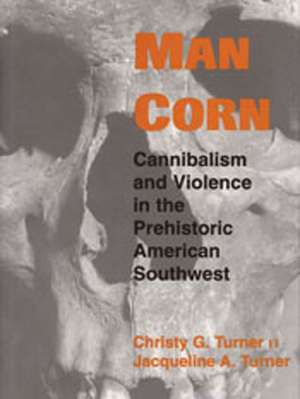Man Corn: Cannibalism and Violence in the Prehistoric American Southwest
Autor Christy G Turner, IIen Limba Engleză Paperback – 30 apr 2011 – vârsta ani
This study of prehistoric violence, homicide, and cannibalism explodes the myth that the Anasazi and other Southwest Indians were simple, peaceful farmers.
Until quite recently, Southwest prehistory studies have largely missed or ignored evidence of violent competition. Christy and Jacqueline Turner’s study of prehistoric violence, homicide, and cannibalism explodes the myth that the Anasazi and other Southwest Indians were simple, peaceful farmers. Using detailed osteological analyses and other lines of evidence the Turners show that warfare, violence, and their concomitant horrors were as common in the ancient Southwest as anywhere else in the world.
The special feature of this massively documented study is its multi-regional assessment of episodic human bones assemblages (scattered floor deposits or charnel pits) by taphonomic analysis, which considers what happens to bones from the time of death to the time of recovery. During the past thirty years, the authors and other analysts have identified a minimal perimortem taphonomic signature of burning, pot polishing, anvil abrasions, bone breakage, cut marks, and missing vertebrae that closely match the signatures of animal butchering and is frequently associated with additional evidence of violence. More than seventy-five archaeological sited containing several hundred individuals are carefully examined for the cannibalism signature. Because this signature has not been reported for any sites north of Mexico, other than those in the Southwest, the authors also present detailed comparisons with Mesoamerican skeletal collections where human sacrifice and cannibalism were known to have been practiced. The authors review several hypotheses for Southwest cannibalism: starvation, social pathology, and institutionalized violence and cannibalism. In the latter case, they present evidence for a potential Mexican connection and demonstrate that most of the known cannibalized series are located temporally and spatially near Chaco great houses.
Preț: 374.36 lei
Preț vechi: 434.86 lei
-14% Nou
Puncte Express: 562
Preț estimativ în valută:
71.63€ • 75.65$ • 59.61£
71.63€ • 75.65$ • 59.61£
Carte indisponibilă temporar
Doresc să fiu notificat când acest titlu va fi disponibil:
Se trimite...
Preluare comenzi: 021 569.72.76
Specificații
ISBN-13: 9780874809688
ISBN-10: 0874809681
Pagini: 552
Ilustrații: 368
Dimensiuni: 216 x 279 x 38 mm
Greutate: 1.38 kg
Ediția:1
Editura: University of Utah Press
Colecția University of Utah Press
ISBN-10: 0874809681
Pagini: 552
Ilustrații: 368
Dimensiuni: 216 x 279 x 38 mm
Greutate: 1.38 kg
Ediția:1
Editura: University of Utah Press
Colecția University of Utah Press
Recenzii
“The Turners make their case convincingly and methodically, but not at the cost of producing an interesting and thought-provoking book. The renegade anthropologists have advanced a theory that has breathed life into a moribund debate, while producing a book absolutely worth reading even for those outside the field.”—San Francisco Bay Guardian
“A fascinating theoretical glimpse into the collapse of a great civilization.”—Los Angeles Times
“Sure to be one of the most controversial books on Southwestern archaeology of our generation.”—American Archaeology
“A remarkable achievement, a joy to read, and a sobering learning experience. This book is one of the few that truly belong on the shelf of every Southwestern archaeologist.”—Kiva
“The first detailed account of cannibalism and violence on a regional scale in the prehistoric American Southwest, especially in the Chaco Canyon area. It’s a shocker.”—High Country News
“A major contribution to understanding taphonomic signatures of human violence and cannibalism and to Southwestern prehistory. Debates over interpretation aside, the Turners’ legacy of objective reporting of the evidence will endure.”—Journal of Anthropological Research
“Presents solid research, with all the information required for critical independent testing by other scientists. An important book for southwestern and American archaeology. Presents significant scientific research that cannot fail to focus the factions of the ‘science wars’ on archaeology, and the relative values of data and discretion in archaeology’s search for truth.”—The Journal of Arizona History
“Both provocative and encyclopedic.”
—Latin American Antiquity
—Latin American Antiquity
Notă biografică
Christy G. Turner II is regents’ professor in the Department of Anthropology at Arizona State University.
The late Jacqueline A. Turner was a ranch manager in Dragoon, Arizona.
The late Jacqueline A. Turner was a ranch manager in Dragoon, Arizona.
Cuprins
Table of Contents:
1. Introduction: Studying Southwestern Cannibalism
2. Interpreting Human Bone Damage: Taphonomic, Ethnographic, and Archaeological Evidence
3. Taphonomic Evidence for Cannibalism and Violence in the American Southwest: Seventy-Six Sites
4. Comparative Evidence: Cannibalism and Human Body Processing in Mexico
5. Conclusion: Explaining Southwestern Cannibalism
Appendix
Acknowledgments
List of Figures
List of Tables
References Cited
Index to Sites
General Index
1. Introduction: Studying Southwestern Cannibalism
2. Interpreting Human Bone Damage: Taphonomic, Ethnographic, and Archaeological Evidence
3. Taphonomic Evidence for Cannibalism and Violence in the American Southwest: Seventy-Six Sites
4. Comparative Evidence: Cannibalism and Human Body Processing in Mexico
5. Conclusion: Explaining Southwestern Cannibalism
Appendix
Acknowledgments
List of Figures
List of Tables
References Cited
Index to Sites
General Index
Descriere
Using detailed osteological analyses and other lines of evidence, this study of prehistoric violence, homicide, and cannibalism explodes the myth that the Anasazi and other Southwest Indians were simple, peaceful farmers.
